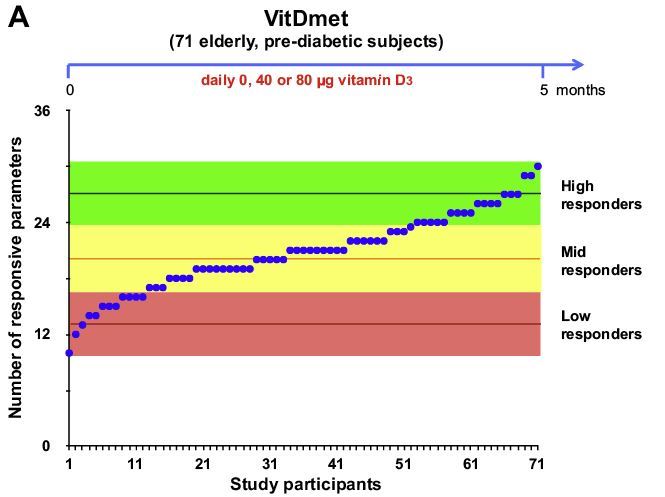Vitamin D non-responders may have one or more poor genes: GC, LIPC, CYP24A1, and PDE3B
Genetic factors help explain the variable responses of young children with cystic fibrosis to vitamin D supplements
Clin Nutr ESPEN 2022 Oct;51:367-376. doi: 10.1016/j.clnesp.2022.07.018
HuiChuan J Lai 1 , Jie Song 2 , Qiongshi Lu 3 , Sangita G Murali 4 , Manavalan Gajapathy 5 , Brandon M Wilk 5 , Donna M Brown 5 , Elizabeth A Worthey 5 , Philip M Farrell 6 , FIRST Study Group
Background & aims: Children with cystic fibrosis (CF) are susceptible to fat-soluble vitamin deficiencies unless supplemented, but even large doses of vitamin D may not prevent low 25-hydroxyvitamin D (25OHD) concentrations. The explanation for these vitamin D non-responders has been elusive. We utilized data from whole genome sequencing (WGS) to test the hypothesis that genetic variations predict responsiveness to vitamin D supplementation in a prospective cohort study of children with CF in the first 3 years of life.
Methods: One hundred and one infants born during 2012-2017 and diagnosed with CF through newborn screening were studied. Serum 25OHD concentrations and vitamin D supplement doses were assessed during early infancy and annually thereafter. WGS was performed, the resultant variant calling files processed, and the summary statistics from a recent genome-wide association study were utilized to construct a polygenic risk score (PRS) for each subject.
Results: Overall, the prevalence of vitamin D insufficiency (<30 ng/mL) was 21% in the first 3 years of life. Among the 70 subjects who always adhered to vitamin D supplement doses recommended by the US CF Foundation guidelines, 89% were responders (achieved vitamin D sufficiency) by 3 years of age, while 1% were transient or non-responders . Multiple regression analysis revealed that PRS was a significant predictor of 25OHD concentrations (p < 0.001) and the likelihood of being an earlier responder in the first 3 years of life (p < 0.01). A limited SNP analysis revealed variants in four important genes ( GC, LIPC, CYP24A1, and PDE3B ) that were shown to be associated with 25OHD concentrations and vitamin D responder status. Other determinants included vitamin D supplement dose, season at 25OHD measurement, and pancreatic functional status.
Conclusions: Applying WGS in conjunction with utilizing a PRS approach revealed genetic variations that partially explain the unresponsiveness of some children with CF to vitamin D supplementation. Our findings suggest that a nutrigenomics strategy could help promote personalized treatment in CF.
See related studies in VitaminDWiki
No response to Vitamin D was 11 X more likely to have if poor Binding gene – Sept 2022 = GC
Boron improves magnesium absorption and may help vitamin D non-responders – Aug 2015
10 reasons for poor response to Vitamin D (race, binding protein, etc.) – Nov 2017
Vitamin D Nutrigenomics - High, Medium, and Low Responders - March 2019
Rare mutation of CYP24A1 gene results in Vitamin D accumulating
-
- Figure 2A daily dose of 3,200 IU

VitaminDWiki - Genetics category contains
{include}
VitaminDWiki - Vitamin D Binding Protein category contains items
{include}
